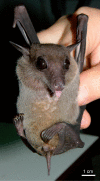Differential pollen placement on an Old World nectar bat increases pollination efficiency
- PMID: 26482654
- PMCID: PMC4701156
- DOI: 10.1093/aob/mcv163
Differential pollen placement on an Old World nectar bat increases pollination efficiency
Abstract
Background and aims: Plant species that share pollinators are potentially subject to non-adaptive interspecific pollen transfer, resulting in reduced reproductive success. Mechanisms that increase pollination efficiency between conspecific individuals are therefore highly beneficial. Many nocturnally flowering plant species in Thailand are pollinated by the nectar bat Eonycteris spelaea (Pteropodidae). This study tested the hypothesis that plant species within a community reduce interspecific pollen movement by placing pollen on different areas of the bat's body.
Methods: Using flight cage trials, pollen transfer by E. spelaea was compared between conspecific versus heterospecific flowers across four bat-pollinated plant genera. Pollen from four locations on the bat's body was also quantified to determine if pollen placement varies by plant species.
Key results: It was found that E. spelaea transfers significantly more pollen between conspecific than heterospecific flowers, and that diverse floral designs produce significantly different patterns of pollen deposition on E. spelaea.
Conclusions: In the Old World tropics, differential pollen placement is a mechanism that reduces competition among bat-pollinated plant species sharing a common pollinator.
Keywords: Ceiba pentandra; Chiropterophily; Durio zibethinus; Musa acuminata; Parkia speciosa; Parkia timoriana.; Pteropodidae; Thailand; bat pollination; floral morphology; interspecific pollen transfer; pollen placement.
© The Author 2015. Published by Oxford University Press on behalf of the Annals of Botany Company. All rights reserved. For Permissions, please email: journals.permissions@oup.com.
Figures




Similar articles
-
Field evidence of strong differential pollen placement by Old World bat-pollinated plants.Ann Bot. 2017 Jan;119(1):73-79. doi: 10.1093/aob/mcw212. Epub 2016 Nov 17. Ann Bot. 2017. PMID: 27864223 Free PMC article.
-
A generalized pollination system in the tropics: bats, birds and Aphelandra acanthus.Ann Bot. 2009 Jun;103(9):1481-7. doi: 10.1093/aob/mcn260. Epub 2009 Jan 8. Ann Bot. 2009. PMID: 19131378 Free PMC article.
-
Limited reproductive interference despite high rates of heterospecific pollen transfer among co-occurring bat-pollinated Burmeistera.Am J Bot. 2023 Jun;110(6):e16199. doi: 10.1002/ajb2.16199. Epub 2023 Jun 15. Am J Bot. 2023. PMID: 37318759
-
Mechanisms and evolution of deceptive pollination in orchids.Biol Rev Camb Philos Soc. 2006 May;81(2):219-35. doi: 10.1017/S1464793105006986. Biol Rev Camb Philos Soc. 2006. PMID: 16677433 Review.
-
Radiation of pollination systems in the Iridaceae of sub-Saharan Africa.Ann Bot. 2006 Mar;97(3):317-44. doi: 10.1093/aob/mcj040. Epub 2005 Dec 23. Ann Bot. 2006. PMID: 16377653 Free PMC article. Review.
Cited by
-
High Resource Overlap and a Consistently Generalised Pattern of Interactions in a Bat-Flower Network in a Seasonally Dry Landscape.Ecol Evol. 2024 Oct 9;14(10):e70367. doi: 10.1002/ece3.70367. eCollection 2024 Oct. Ecol Evol. 2024. PMID: 39385843 Free PMC article.
-
Field evidence of strong differential pollen placement by Old World bat-pollinated plants.Ann Bot. 2017 Jan;119(1):73-79. doi: 10.1093/aob/mcw212. Epub 2016 Nov 17. Ann Bot. 2017. PMID: 27864223 Free PMC article.
-
Variation in floral morphology, histochemistry, and floral visitors of three sympatric morning glory species.PeerJ. 2024 Aug 26;12:e17866. doi: 10.7717/peerj.17866. eCollection 2024. PeerJ. 2024. PMID: 39210916 Free PMC article.
-
Why honeybees are poor pollinators of a mass-flowering plant: Experimental support for the low pollen quality hypothesis.Am J Bot. 2022 Aug;109(8):1305-1312. doi: 10.1002/ajb2.16036. Epub 2022 Aug 23. Am J Bot. 2022. PMID: 35844034 Free PMC article.
-
Effective pollination of Aeschynanthus acuminatus (Gesneriaceae) by generalist passerines, in sunbird-absent East Asia.Sci Rep. 2019 Nov 26;9(1):17552. doi: 10.1038/s41598-019-53035-2. Sci Rep. 2019. PMID: 31772181 Free PMC article.
References
-
- Acharya PR, Racey PA, Sotthibandhu S, Bumrungsri S. 2015. Feeding behaviour of the dawn bat (Eonycteris spelaea) promotes cross pollination of economically important plants in Southeast Asia. Journal of Pollination Ecology 15: 44–50.
-
- Andersson L. 1998. Musaceae In: K Kubitzki, H Huber, eds. Flowering plants. Monocotyledons. Berlin: Springer, 296–301.
-
- Armbruster WS, Edwards ME, Debevec EM. 1994. Floral character displacement generates assemblage structure of Western Australian triggerplants (Stylidium). Ecology 75: 315–329.
-
- Baker HG, Harris BJ. 1957. The pollination of Parkia by bats and its attendant evolutionary problems. Evolution 11: 449–460.
Publication types
MeSH terms
Substances
LinkOut - more resources
Full Text Sources
Other Literature Sources

